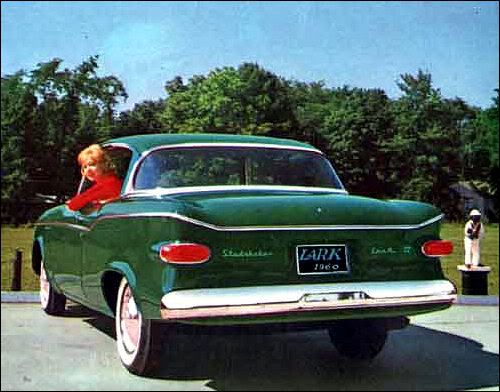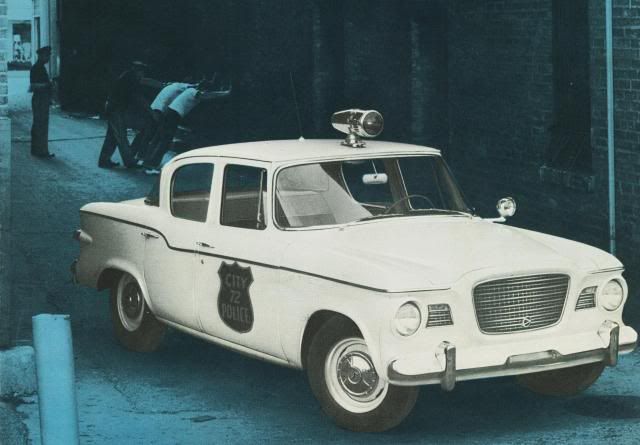The Studebaker Lark is almost identical this year to the original 1959 car. Only small modifications to the grille and overall front end can help differentiate them. The big - and rather unfortunate - news for the compact Studebaker is the arrival on this market of rivals proposed by all of the three major Detroit corporations (the Ford Falcon, the Chevrolet Corvair and the Valiant), though the Lark’s share remains relatively unscathed this year.
Studebaker Lark DeLuxe
The Lark DeLuxe is a very plain car, sporting less chrome on its front end than virtually any other vehicle built in Detroit. New this year is a practical four-door variant of the station wagon.

● Introduction: 1952 as the original full-size model, fall 1958 as the shortened and heavily reworked compact. Construction: body on separate chassis. Engine: water-cooled inline six, 2.8-litre, 90 hp, mounted at the front (Lark VI). Optional engine: V-8, 4.2-litre, 180 hp (Lark VIII). Lower compression ratios (and hence lower outputs) could be ordered for exported cars in order to cope with gasoline with poorer octane rates. Transmission: to the rear wheels through a three-speed manual gearbox. Three-speed automatic gearbox optional. Suspension: independent at the front, rigid axle at the rear. Brakes: hydraulic, to drums on all four wheels. Servo optional. Length: 445 cm (sedans), 469 cm (station wagon). Top speed: n/a. Range: two-door sedan, four-door sedan, two-door station wagon, four-door station wagon.
Studebaker Lark Regal
The Lark Regal adds more chrome around the headlights and offers a padded instrument panel. As the DeLuxe, it is split into two series, “Lark VI” or “Lark VIII” depending on the number of cylinders of their engine. A convertible with a standard power top returns to Studebaker’s range - the first of its kind since 1952.

● Introduction: 1952 as the original full-size model, fall 1958 as the shortened and heavily reworked compact. Construction: body on separate chassis. Engine: water-cooled inline six, 2.8-litre, 90 hp, mounted at the front (Lark VI). Optional engine: V-8, 4.2-litre, 180 hp (Lark VIII). Lower compression ratios (and hence lower outputs) could be ordered for exported cars in order to cope with gasoline with poorer octane rates. Transmission: to the rear wheels through a three-speed manual gearbox. Three-speed automatic gearbox optional. Suspension: independent at the front, rigid axle at the rear. Brakes: hydraulic, to drums on all four wheels. Servo optional. Length: 445 cm (sedan and hardtop coupe), 469 cm (station wagon). Top speed: n/a. Range: four-door sedan, two-door hardtop coupe, two-door convertible coupe, four-door station wagon.
Studebaker Lark Econ-O-Miler
In addition to these models accessible to the general public, Studebaker also proposes a variant of the Lark specially intended for fleets, mostly taxicab operators. It is built on the longer chassis of the station wagon, but exclusively available as a four-door sedan.
● Introduction: 1952 as the original full-size model, fall 1958 as the shortened and heavily reworked compact. Construction: body on separate chassis. Engine: water-cooled inline six, 2.8-litre, 90 hp, mounted at the front (Lark VI). Optional engine: V-8, 4.2-litre, 180 hp (Lark VIII). Transmission: to the rear wheels through a three-speed manual gearbox. Suspension: independent at the front, rigid axle at the rear. Brakes: hydraulic, to drums on all four wheels. Servo optional. Length: 455 cm. Top speed: n/a. Range: four-door sedan.
Studebaker Lark Marshal
Caring for fleet operators, Studebaker also proposes in a variety of bodies a Lark designed for law agencies. On special request, it can be powered by the Hawk’s V-8, which guarantees spectacular performances to the small and light car.

● Introduction: 1952 as the original full-size model, fall 1958 as the shortened and heavily reworked compact. Construction: body on separate chassis. Engine: water-cooled inline six, 2.8-litre, 90 hp, mounted at the front (Lark VI). Optional engines: V-8, 4.2-litre, 180 hp; and V-8, 4.7-litre, 210 hp (Lark VIII). Transmission: to the rear wheels through a three-speed manual gearbox. Three-speed automatic gearbox optional. Suspension: independent at the front, rigid axle at the rear. Brakes: hydraulic, to drums on all four wheels. Servo optional. Length: 445 cm (sedans), 455 cm (long-wheelbase sedan), 469 cm (station wagons). Top speed: n/a. Range: two-door sedan, four-door sedan, four-door extended “heavy duty” sedan, two-door station wagon, four-door station wagon.
Any mistake you’ve just spotted? A detail to add? A suggestion? Don’t hesitate to leave a comment!
Click to jump to another model year of the same car: 1959 – 1960 – 1961 – 1962 – 1963 – 1964 – 1965 – 1966
Click here to return to a list of all Studebaker vehicles presented on this blog.
Click here to return to this blog’s initial post, featuring a list of all brands already presented.
Studebaker Lark DeLuxe
The Lark DeLuxe is a very plain car, sporting less chrome on its front end than virtually any other vehicle built in Detroit. New this year is a practical four-door variant of the station wagon.

● Introduction: 1952 as the original full-size model, fall 1958 as the shortened and heavily reworked compact. Construction: body on separate chassis. Engine: water-cooled inline six, 2.8-litre, 90 hp, mounted at the front (Lark VI). Optional engine: V-8, 4.2-litre, 180 hp (Lark VIII). Lower compression ratios (and hence lower outputs) could be ordered for exported cars in order to cope with gasoline with poorer octane rates. Transmission: to the rear wheels through a three-speed manual gearbox. Three-speed automatic gearbox optional. Suspension: independent at the front, rigid axle at the rear. Brakes: hydraulic, to drums on all four wheels. Servo optional. Length: 445 cm (sedans), 469 cm (station wagon). Top speed: n/a. Range: two-door sedan, four-door sedan, two-door station wagon, four-door station wagon.
Studebaker Lark Regal
The Lark Regal adds more chrome around the headlights and offers a padded instrument panel. As the DeLuxe, it is split into two series, “Lark VI” or “Lark VIII” depending on the number of cylinders of their engine. A convertible with a standard power top returns to Studebaker’s range - the first of its kind since 1952.

● Introduction: 1952 as the original full-size model, fall 1958 as the shortened and heavily reworked compact. Construction: body on separate chassis. Engine: water-cooled inline six, 2.8-litre, 90 hp, mounted at the front (Lark VI). Optional engine: V-8, 4.2-litre, 180 hp (Lark VIII). Lower compression ratios (and hence lower outputs) could be ordered for exported cars in order to cope with gasoline with poorer octane rates. Transmission: to the rear wheels through a three-speed manual gearbox. Three-speed automatic gearbox optional. Suspension: independent at the front, rigid axle at the rear. Brakes: hydraulic, to drums on all four wheels. Servo optional. Length: 445 cm (sedan and hardtop coupe), 469 cm (station wagon). Top speed: n/a. Range: four-door sedan, two-door hardtop coupe, two-door convertible coupe, four-door station wagon.
Studebaker Lark Econ-O-Miler
In addition to these models accessible to the general public, Studebaker also proposes a variant of the Lark specially intended for fleets, mostly taxicab operators. It is built on the longer chassis of the station wagon, but exclusively available as a four-door sedan.
● Introduction: 1952 as the original full-size model, fall 1958 as the shortened and heavily reworked compact. Construction: body on separate chassis. Engine: water-cooled inline six, 2.8-litre, 90 hp, mounted at the front (Lark VI). Optional engine: V-8, 4.2-litre, 180 hp (Lark VIII). Transmission: to the rear wheels through a three-speed manual gearbox. Suspension: independent at the front, rigid axle at the rear. Brakes: hydraulic, to drums on all four wheels. Servo optional. Length: 455 cm. Top speed: n/a. Range: four-door sedan.
Studebaker Lark Marshal
Caring for fleet operators, Studebaker also proposes in a variety of bodies a Lark designed for law agencies. On special request, it can be powered by the Hawk’s V-8, which guarantees spectacular performances to the small and light car.

● Introduction: 1952 as the original full-size model, fall 1958 as the shortened and heavily reworked compact. Construction: body on separate chassis. Engine: water-cooled inline six, 2.8-litre, 90 hp, mounted at the front (Lark VI). Optional engines: V-8, 4.2-litre, 180 hp; and V-8, 4.7-litre, 210 hp (Lark VIII). Transmission: to the rear wheels through a three-speed manual gearbox. Three-speed automatic gearbox optional. Suspension: independent at the front, rigid axle at the rear. Brakes: hydraulic, to drums on all four wheels. Servo optional. Length: 445 cm (sedans), 455 cm (long-wheelbase sedan), 469 cm (station wagons). Top speed: n/a. Range: two-door sedan, four-door sedan, four-door extended “heavy duty” sedan, two-door station wagon, four-door station wagon.
Any mistake you’ve just spotted? A detail to add? A suggestion? Don’t hesitate to leave a comment!
Click to jump to another model year of the same car: 1959 – 1960 – 1961 – 1962 – 1963 – 1964 – 1965 – 1966
Click here to return to a list of all Studebaker vehicles presented on this blog.
Click here to return to this blog’s initial post, featuring a list of all brands already presented.
This is a charming car of surprising virtues, not the least of which is the spaciousness of its interior, given its compact external dimensions. I owned a '60 Lark for 18 months two years ago. It served me well as a daily driver--never leaving me stranded. The only reason I gave it up is I can only afford one car, and I did't want this little charmer to suffer any more Michigan winters.
ReplyDeleteI used to know someone who had a 1960 Studebaker Lark VIII. It was as basic as one could've asked for. It had no radio, it had no speaker that I could see. It had a V8 engine. It had automatic transmission.
ReplyDelete